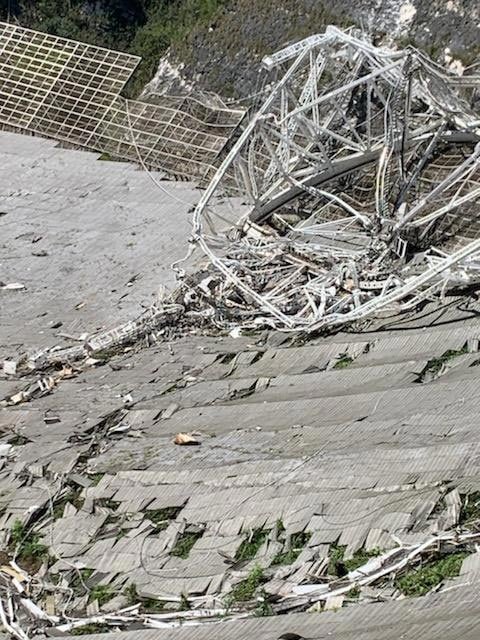Dramatic Video of the Collapse of Arecibo Observatory’s Massive 305-Meter Telescope
A starry sky above the Arecibo Observatory in Puerto Rico. Credit: University of Central Florida
The instrument platform of the 305-meter telescope at Arecibo Observatory in Puerto Rico fell at approximately 7:55 a.m. Atlantic Standard Time on December 1, resulting in damage to the dish and surrounding facilities.
No injuries were reported as a result of the collapse. The U.S. National Science Foundation ordered the area around the telescope to be cleared of unauthorized personnel since the failure of a cable on November 6. Local authorities will keep the area cordoned off as engineers work to assess the stability of the observatory’s other structures.
Top priorities are maintaining safety at the site, conducting a complete damage assessment as quickly as possible, and taking action to contain and mitigate any environmental damage caused by the structure or its materials. While the telescope was a key part of the facility, the observatory has other scientific and educational infrastructure that NSF will work with stakeholders to bring back online.

Damage sustained at the Arecibo Observatory 305-meter telescope. Credit: University of Central Florida
“We are saddened by this situation but thankful that no one was hurt,” said NSF Director Sethuraman Panchanathan. “When engineers advised NSF that the structure was unstable and presented a danger to work teams and Arecibo staff, we took their warnings seriously and continued to emphasize the importance of safety for everyone involved. Our focus is now on assessing the damage, finding ways to restore operations at other parts of the observatory, and working to continue supporting the scientific community, and the people of Puerto Rico.”
The investigation into the platform’s fall is ongoing. Initial findings indicate that the top section of all three of the 305-meter telescope’s support towers broke off. As the 900-ton instrument platform fell, the telescope’s support cables also dropped.
Preliminary assessments indicate the observatory’s learning center sustained significant damage from falling cables.
Engineers arrived on-site today. Working with the University of Central Florida, which manages the observatory, NSF expects to have environmental assessment workers on-site as early as tomorrow. Workers at the observatory will take appropriate safety precautions as a full assessment of the site’s safety is underway.
“We knew this was a possibility, but it is still heartbreaking to see,” says Elizabeth Klonoff, UCF’s vice president for research. “Safety of personnel is our number one priority. We already have engineers on site to help assess the damage and determine the stability and safety of the remaining structure. We will continue to work with the NSF and other stakeholders to find ways to support the science mission at Arecibo.”
NSF intends to continue to authorize UCF to pay Arecibo staff and take actions to continue research work at the observatory, such as repairing the 12-meter telescope used for radio astronomy research and the roof of the LIDAR facility, a valuable geospace research tool. These repairs were funded through supplemental congressional appropriations aimed at addressing damage from Hurricane Maria.
Once safety on site is established, other work at the observatory will be carried out as conditions permit.
Background
Although the platform’s fall was unplanned, NSF, UCF, and other stakeholders, including engineering firms contracted by UCF, had been monitoring developments at the 305-meter telescope that indicated an increased risk of a collapse.
In August, one of the 305-meter telescope’s cables unexpectedly detached. The remaining cables were expected to bear the load without issue as engineers worked on plans to address the damage. However, a second cable broke on November 6. Engineers subsequently found the second snapped at about 60% of what should have been its minimum breaking strength, indicating that other cables may be weaker than expected, and advised that the structure could not be safely repaired.
Both cables were attached to the same support tower. If the tower lost another cable, the engineer of record noted, an unexpected collapse would be the likely result. Since NSF’s November 19 announcement that it would plan for decommissioning of the 305-meter telescope, surveillance drones found additional exterior wire breaks on two cables attached to the same tower. One showed between 11-14 broken exterior wires as of November 30 while another showed about eight. Each cable is made up of approximately 160 wires.
Met One Instruments, Inc. is proud to have monitored the Arecibo site since 1993 and hope they are back up and running in the near future.
Comments
Post a Comment